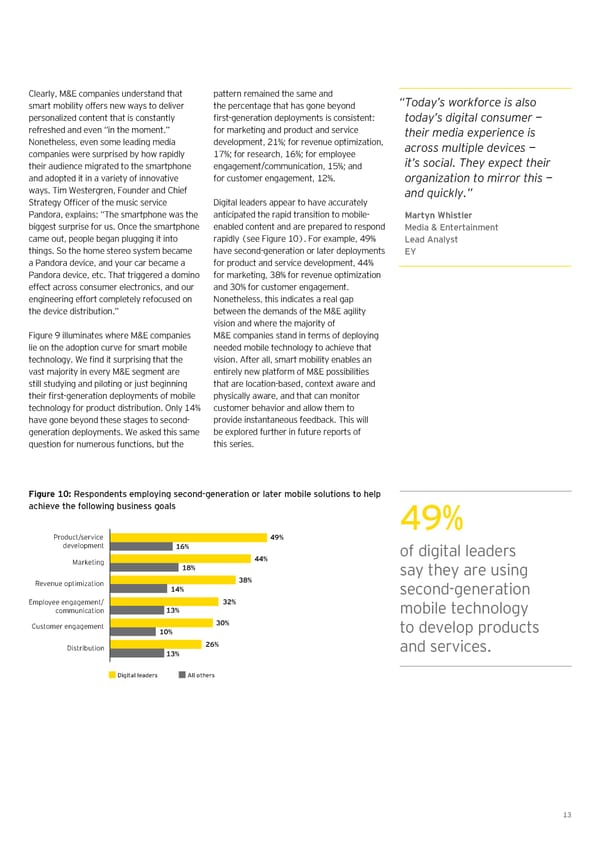Clearly€ M&E companies understand that pattern remained the same and “ Today’s workforce is also smart mobility oers ne‚ ‚ays to deliver the percentage that has gone beyond personaliœed content that is constantly firstgeneration deployments is consistent’ today’s digital consumer — rereshed and even “in the momentŠ” or marŒeting and product and service their media eperience is onetheless€ even some leading media development€ ‡ˆ”• or revenue optimiœation€ across multiple deices — companies ‚ere surprised by ho‚ rapidly ˆ¨”• or research€ ˆ™”• or employee it’s social. They epect their their audience migrated to the smartphone engagement¯communication€ ˆ„”• and and adopted it in a variety o innovative or customer engagement€ ˆ‡”Š organiƒation to mirror this — ‚aysŠ Tim Žestergren€ Founder and Chie and uickly.” trategy ƒficer o the music service ¦igital leaders appear to have accurately £andora€ eplains’ “The smartphone ‚as the anticipated the rapid transition to mobile artyn €hiter biggest surprise or usŠ ƒnce the smartphone enabled content and are prepared to respond Media & Entertainment came out€ people began plugging it into rapidly ˜see Figure ˆ…šŠ For eample€ ¥“” Lead ƒnalyst thingsŠ o the home stereo system became have secondgeneration or later deployments EY a £andora device€ and your car became a or product and service development€ ¥¥” £andora device€ etcŠ That triggered a domino or marŒeting€ ‰ž” or revenue optimiœation eect across consumer electronics€ and our and ‰…” or customer engagementŠ engineering eort completely reocused on onetheless€ this indicates a real gap the device distributionŠ” bet‚een the demands o the M&E agility vision and ‚here the ma«ority o Figure “ illuminates ‚here M&E companies M&E companies stand in terms o deploying lie on the adoption curve or smart mobile needed mobile technology to achieve that technologyŠ Že find it surprising that the visionŠ Ater all€ smart mobility enables an vast ma«ority in every M&E segment are entirely ne‚ platorm o M&E possibilities still studying and piloting or «ust beginning that are locationbased€ contet a‚are and their firstgeneration deployments o mobile physically a‚are€ and that can monitor technology or product distributionŠ ƒnly ˆ¥” customer behavior and allo‚ them to have gone beyond these stages to second provide instantaneous eedbacŒŠ This ‚ill generation deploymentsŠ Že asŒed this same be eplored urther in uture reports o uestion or numerous unctions€ but the this seriesŠ Figure 1“: Žespondents employing secondgeneration or later mobile solutions to help achiee the folloing business goals †¢ž Product/service 49% Product/service 49% development 16% development 16% o digital leaders Marketing 44% Marketing 18% 43% 18% say they are using Revenue optimization 38% Revenue optimization 14% 38% secondgeneration 14% Employee engagement/ 32% Employee engagement/ 13% 32% communication 13% mobile technology communication Customer engagement 30% Customer engagement 10% 30% to develop products 10% Distribution 26% and servicesŠ Distribution 13% 26% 13% Digital leaders Followers Digital leaders All others §
 Digital Agility Now Page 12 Page 14
Digital Agility Now Page 12 Page 14